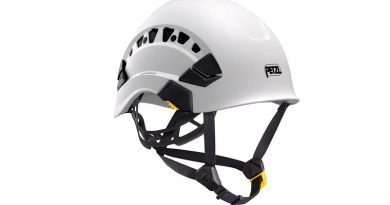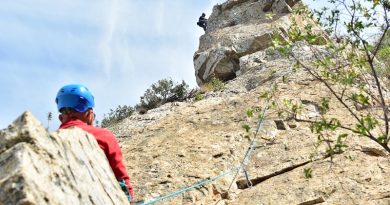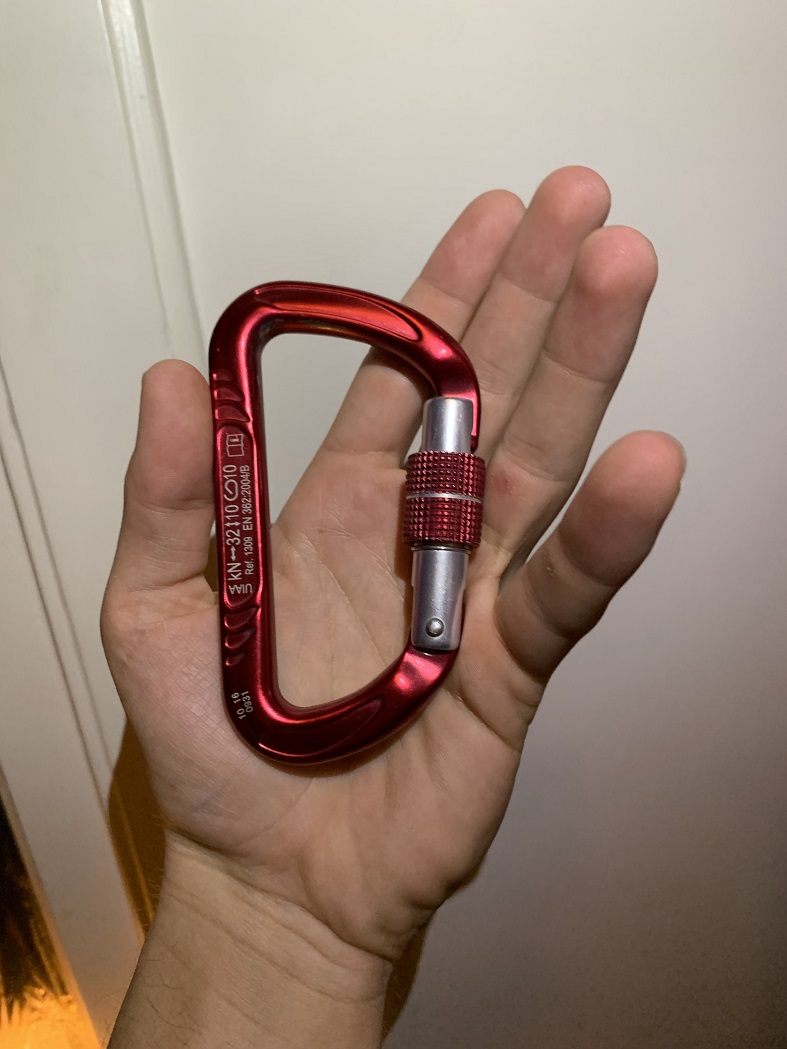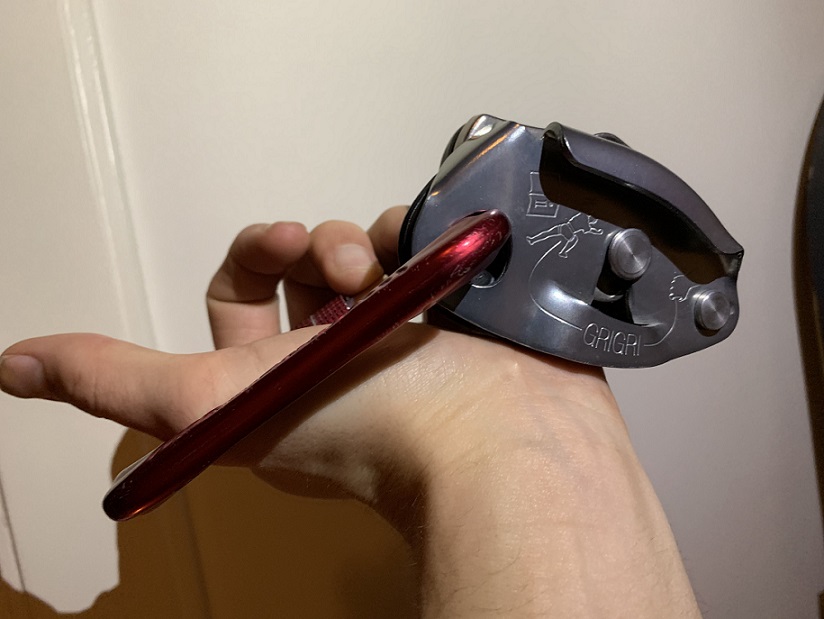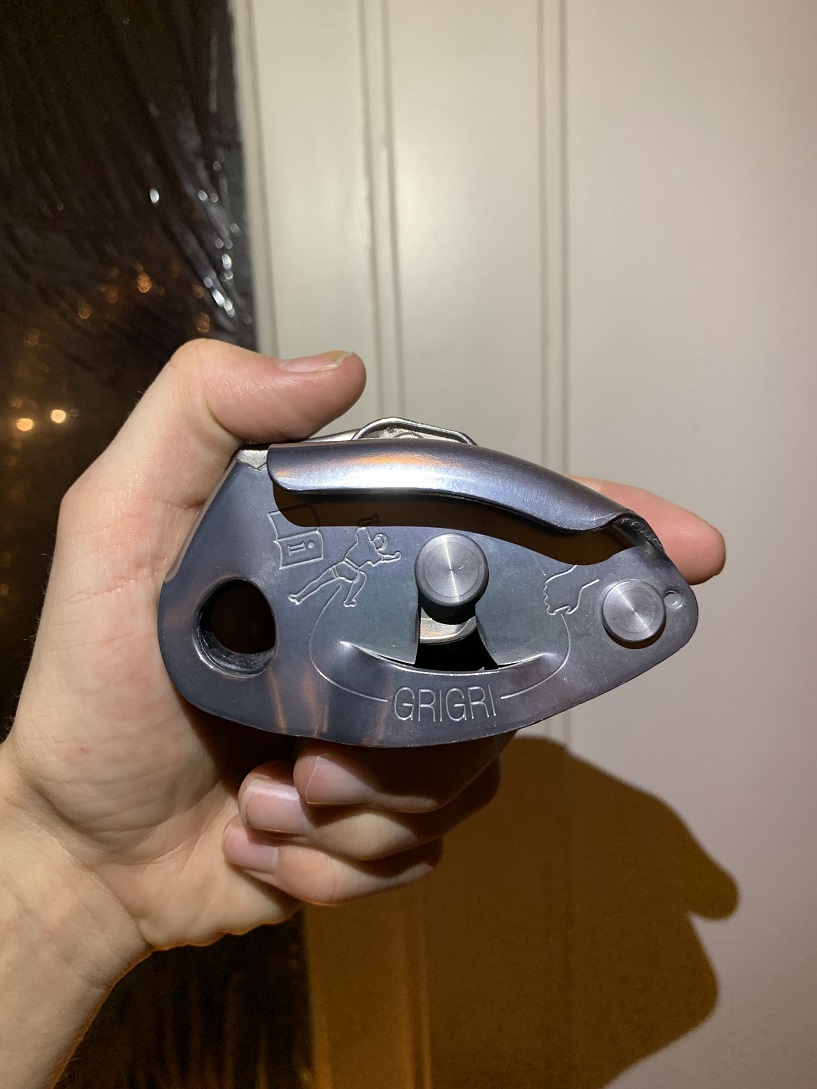Now that the world is in a global pandemic, climbers like myself flock towards fingerboards more than ever before. Using a hangboard is a great way to stay in shape while the climbing gymns are closed. But honestly; it was already a quintessential part of any serious climber’s training schedule, so why not use the virus to our advantage and up our climbing game with one of the best fingerboards?
So let me take you by your (soon to be very muscular) hand and show you the 10 best climbing fingerboards!
Below, we’ll go in depth about each of these fingerboards. We’ll also discuss what to look for in a fingerboard in general.
If you simply can’t wait to get started hanging, here’s the list already of the 10 best climbing fingerboards that we’ll discuss in this article:
Click on a link in the left column to immediately jump down to my review of that particular item.
| 1. Trango Rock Prodigy Training Center | Best Fingerboard for Beginners | |
| 2. Metolius Simulator 3D | Beste Value | |
| 3. Beastmaker 2000 | Best for Experienced Climbers | |
| 4. Metolius Wood Grips Compact I | Best low-Cost Fingerboard | |
| 5. Moon Fingerboard | Best Fingerboard for Fragile Mounting | |
| 6. Metolius Wood Grips Compact II | Best Fingerboard for Durability | |
| 7. Problemsolver | Best Organic Training board | |
| 8. Beastmaker 1000 | Best Wooden Fingerboard | |
| 9. Zlagboard | Best Smart Fingerboard | |
| 10. Blank Slate Climbing APEX S2-W | Best Fingerboard for Renters |
What is a Fingerboard?
Fingerboards, also known as hangboards, are among the most common rock climbing training tools.
Easy to use, these training tools have become a crucial part of every experienced rock climber’s regime.
Developed in the 1980s, fingerboards allow for a complete workout of some of the most important muscle groups used when climbing.
These simple tools provide the best-possible workout for training grip strength and also allow for intense arm and shoulder exercises. In doing so, they allow rock climbers to strengthen the upper body and hands to allow them to make more difficult climbs.

As we will see, most rock climbers don’t recommend fingerboards to those who aren’t at least at an intermediate level yet.
If you’ve reached this level—or if you think you will soon—it’s time to start looking for a fingerboard that may be right for you.
But with so many on the market, how do you know which one to choose? You may have been given different fingerboard recommendations by all of your friends, leaving you confused about which one you should buy.
Don’t be discouraged. The reason that you’re likely to get so many different answers is because there are several quality fingerboards out there. The trick is knowing what they’re good for.
Because here’s the thing: not all fingerboards are made equal. But just because one is better in a certain area doesn’t mean that there’s not another fingerboard that’s better in another way.
It’s all about finding one that works best for your specific situation so that you can train to get better. And because your training needs may be different than someone else’s, it makes sense that the fingerboard you use might not be the same.
So how do you know which fingerboard to use? Are there certain qualities you should be looking for in a fingerboard? If so, what are they, and how do you know what they are?
The answer is yes—and the good news is below, I’ll walk you through some of the best fingerboards on the market. We’ll also go over the different things you should look out for when selecting your fingerboard.
By using this information, you can find the right equipment to boost your workout. And by getting a fingerboard that’s right for you, you’ll start to progress to bigger and better climbs more quickly than you ever thought possible.
With that in mind, let’s take a look at some of the most important considerations you can make when selecting your fingerboard.
Click here to jump to the reviews down below >>
Qualities to Look for in a Fingerboard
To some degree, the qualities that you look for when you choose your fingerboard will depend on your situation.
While there’s a set number of categories, the one’s that you value will be subjective. You may want to invest in a fingerboard that provides top-notch endurance training, for example, while those just starting out might want something that’s easy to mount and use.
Because of this, it’s important that you assess your personal situation before you make your fingerboard investment. This is especially true if you’re working on a budget. Making sure that you get the right fingerboard is vital to your training success.
Now, don’t get me wrong. It’s possible to get a good workout even if the fingerboard you buy isn’t optimally suited for you. If you really want to get the most out of your workout, however, it’s always best to get a fingerboard tailored to your situation.
If you’re not sure what you should be looking for in a fingerboard, consider asking some more-experienced climbers. If you’ve got an instructor, it’s worth asking them. Take the time to have someone more knowledgeable than you look at the situation and help you out.
Below, I’ve included some of the different things you should be looking out for when selecting your fingerboard.
Keep this information in mind to make sure that you get the fingerboard that’s right for you.
Pick a Type of Fingerboard That Suits You
First, it’s important to note that not all fingerboards are even the same type. Because of different widths, hold sizes, textures, etc., various fingerboards are better suited for different purposes.
With the development of fingerboard technology, it’s now even possible to buy fingerboards that are smartphone-compatible. Tried-and-true wooden designs are also available.
As you look through different fingerboard options, you’ll quickly notice that some are simply more complex than others. They have more holes at more angles and generally allow for a better workout.
If you’re new to hangboarding, you’ll likely want to go with something a little simpler. However, if you’re looking to take your workout to the next level, there are several different fingerboards that will allow you to progress.
You Want a Fingerboard With a Good Variety of Hold Types
One of the most powerful ways fingerboards do this is through the different hold types they offer.
More advanced hangboards provide a wider array of hold and grip types—meaning that you can get a more-inclusive workout. From slopers and crimps to edges and pockets, these boards can help strengthen the various holds used while climbing.
To know which fingerboard is best for you in this regard, it’s important to know just skilled you are. Those new to fingerboarding will likely not need to train the many different grips offered by some hangboards.
But as paradoxical as it sounds, advanced fingerboards can be used by beginning hangboarders. Though they may be more confusing to use at first, many rock climbers prefer buying complex fingerboards because they allow for better progression. It’s also common that beginning fingerboarders find it easier to use these more-advanced hangboards because of their various fingerholes of different shapes and sizes.
In other words, as they master one grip, they are able to move to another, more challenging one. Keep this in mind when selecting your fingerboard.
Size Matters
The hold size that you’re working with can limit the types of training that you can do.
Smaller sizes, for instance, can keep you from being able to practice certain holds and from doing specific workouts.
Keep this in mind as you select your board, though it likely won’t be an issue until you’ve progressed quite a bit in your fingerboarding.
Pay Attention to Texture: Wood or Polyester?
One of the most important considerations you can make when choosing your fingerboard is the texture.
Why?
Because you’re going to want to find a good-quality texture if you’re going to protect your fingers. Cheap wooden fingerboards, for instance, can start to wear under repeated use and leave jagged edges and splinters—making the board effectively useless.
As you can see, it’s vital that you invest in a texture that facilitates a proper workout. This means one that won’t wear out over time—and one that allows for a good grip. You certainly don’t want to start slipping while doing your workout.
Because of this, you need to understand the textures different fingerboard materials provide.
Fingerboards are typically made in one of two ways from three different materials:
They can either be wooden, or they are made from a polyester resin and polyurethane mix. They each have their pros and cons, so let’s take a moment to examine these materials more in-depth:
Wood
Wood is a popular fingerboard-making material, and many rock climbers like the sleek feel and finish that wood provides. If made well, these boards aren’t likely to give out—even with repeated use.
On the flip side, they are generally lighter in weight—making them easier to carry and not as much of a pain to mount.
Polyester Resin and Polyurethane Mix
In addition to providing a better grip, these fingerboards have several other advantages. Namely, they typically allow for a greater variety and depth of holds. This makes them a great alternative to more experienced fingerboarders looking to get a more intense workout.
The downside for these fingerboards comes mainly in the aesthetic and mounting departments. They don’t have quite the same level of eye-catching polish as their wooden counterparts, and they may be bulkier, too. This makes them more difficult to hang.
Polyester fingerboards provide better grip, but are heavier and more difficult to mount.
Multi-Purpose Fingerboards
As you may be able to tell, more complex fingerboards will add another layer to your workout. In addition to the various holds that you’ll be able to practice, you can also start training other muscle groups.
For instance, after you’ve gotten used to dead hangs, you may even consider adding pullups into your fingerboarding routine. Because you can vary the grip you’re using, you’ll be able to train your upper body in ways that mimic real rock climbing. The goal, of course, is to build upper body power to keep you safer while you’re out on the rocks.
The more hold options that you have, the more variation you will have in building your upper body strength. From our grip and arms to your shoulders and elbows, complex fingerboards help target more upper-body areas. The more you can train, the better off you will be when you actually hit the rocks.
Just remember: don’t try to get it all in at once. Take your workout slow and steady and gradually work up to more intense routines.
Durability
No fingerboard is immune to wear and tear.
But if you invest in a quality brand, you’re more likely to get a couple of extra years out of your fingerboard.
While cheaper options are okay in a pinch and on a budget, it’s a good idea to purchase a more durable board as soon as possible. Because they have to bear your body weight, it’s important that they stay in good working condition.
Ease of Mounting
A fingerboard won’t do you much good if you can’t get it mounted.
You’d be surprised at how difficult it can be to mount some types of hangboards—even for experts. For this reason, it’s important that you get a fingerboard that you can hang easily.
There are several factors that determine how easy a fingerboard is to hang.
Namely, you’re going to need a size big enough to hang the board—such as a ledge above your door. If the space isn’t big enough—or if the fingerboard is too big—this will obviously pose an issue.
Heavier fingerboards can also be more difficult to mount—which is a shame, really, because these are the ones that usually offer greater functionality.
Before you purchase a fingerboard, make sure that you understand your space and weight requirements. In other words, be sure that you have a space that can accommodate the size and the weight of your new fingerboard. So always remember to take measurements before you purchase your board.
Are Fingerboards Right for Beginners?
Though you may want to jump straight into training your grip, most rock climbers don’t recommend fingerboards for beginners.
For those who are just starting out, there’s nothing better than climbing itself to better one’s grip.
In fact, it’s possible that you could seriously injure yourself if you start fingerboarding before you’re ready.
I know it sounds dramatic—but trust me: even experienced climbers can sometimes pull or strain muscles and be put out of climbing for several weeks with improper technique.
And if you’re new to climbing, the likelihood that this will happen is simply greater. Not only are you not as accustomed to proper techniques, it’s likely that you don’t have the right muscle development yet.
From your fingers and your shoulders to your arms, your fingerboard will target several different areas of your body. You want to make sure that you have enough development in these areas to withstand a workout.
It’s also true that if you’re just starting out, you’re not going to need the extra training anyway. The rock climbing that you will be doing won’t require that you have such an advanced level of muscle development.
Believe me—you’ll likely know when it’s time to start fingerboarding. The climbs that you are used to will suddenly be too easy, but the climbs that you’re wanting to do will be beyond your ability.
When you reach this point, it’s likely that you’re ready to move on from simple climbs to more complex ones. And your fingerboard can get you there.
Even still, you don’t want to jump straight into intense fingerboard workouts. Though you’re going to have better grip and arm strength than you did before you started climbing, keep in mind that fingerboards provide a deceptively-difficult workout.
In other words, hanging by your fingers is harder than it seems. That goes without saying that it gets even harder with workout variations.
As with all workouts, you’re going to want to take your fingerboarding slow and steady and gradually work your way into a solid routine.
Being overeager and doing too much won’t help you be a better rock climber. What it’s more likely to do is put you out of commission for several weeks.
With that being said, it’s time that we take a look at the ten best fingerboards on the market. But instead of simply giving you a top ten list, I’ve decided to break it down by category. It’s important that you can understand the best use of a certain fingerboard so that you can get the most from your workout.
Keep these different categories in mind as you look to select your fingerboard.
And don’t be afraid to limit yourself to just one. If you’re just starting out, that’s probably good enough, but for those who are more experienced, there’s nothing wrong with having a variety of fingerboards. Because they can help target different areas of your muscle development, having different fingerboards may be of use. Over the years, it’s likely that you will start to keep a collection of different fingerboards, anyway, and it’s rare that you find a fingerboard so good that you simply stop using the others.
You may also come across different kinds of fingerboards in your local climbing gym, so it’s good to be acquainted with which boards are good for what purpose.
So without further ado, let’s take a look at my list of the top ten fingerboards.
1. Trango Rock Prodigy Training Center: Best Fingerboard for Beginners

Are you looking for a lightweight fingerboard to break you into fingerboarding?
If so, the Trango Rock Prodigy Training Center might be the right choise for you. Engineered with years of technological innovation, this fingerboard is the top option for all climbers who are looking to take their game to the next level.
It’s a pretty ugly fingerboard in my opinion, though, but I’ve seen so many climbers being over the moon about this hangboard, that this ugly duckling deserved the first spot.
Why do climbers love the Trango Rock Prodigy Training Center so much? Simply put, it’s one of the most precise fingerboards on the market, making it a perfect practice tool. We can think of no better fingerboard for any beginner looking to get into the sport.
- Customizable: This customizable fingerboard allows you to get the proper positioning for the best climb! This is perfect for those beginners who are looking to get into the sport.
- Great Texture: The Trango Rock Prodigy Training Center has one of the best textures around. With a gentle, firm grip that provides “rock”-solid support, this is a fingerboard you can count on to get the job done.
- Price: Compared to other fingerboards, the Trango Rock Prodigy Training Center is a little on the pricey side. Still, for the value, this is a bargain price.
2. Metolius Simulator 3D: Best Value Fingerboard

Are you looking for a value fingerboard that will help you grow on a budget?
The Metolius Simulator 3D is probably your best bet.
Sharply priced, this fingerboard offers a variety of holds to increase your climbing skills.
What’s more, because the holds are tapered outward and downward around the device, it’s perfect for beginner and mid-level climbers alike.
Let’s take a look at a few pros and cons for the Simulator 3D.
- Grained Texture: The Simulator 3D’s grain texture isn’t harsh or rough on your skin. This means that you can practice your holds for longer durations. If you’re looking for a quality fingerboard, go with this comfortable option.
- Color Designs: The designs on the Simulator 3D can be pretty sick. Available in three swirl options (white/green, white/blue, and white/black), these psychedelic fingerboards can have you practicing your holds in style.
- Difficulty: This fingerboard may be too easy for more experienced climbers. Advanced climbers may be disappointed in the holds on this board, which aren’t as diverse or as difficult as some pricier options.
3. Beastmaker 2000: Best Fingerboard for Experienced Climbers
So you’ve mastered the beginner boards and are looking for something a little more advanced.
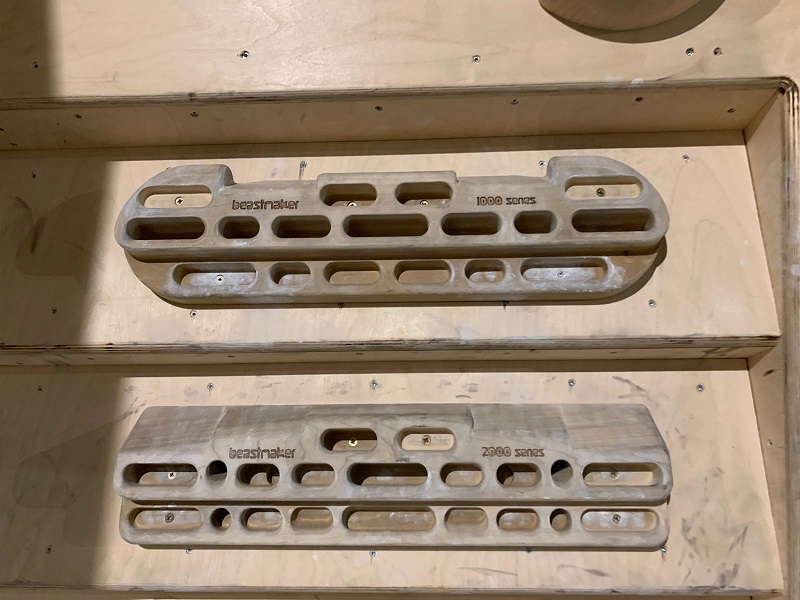
That’s where the Beastmaker 2000 comes in. With a wood design that’s crafted to test and improve your finger strength and skills, this product truly will make you a climbing beast.
With 20, 35, and 45-degree slopers, this is a versatile product that does everything you want it to do. Let’s take a look at a few of the pros and cons of this device to see if it’s the best purchase for you.
If you’re looking for a comparison between the Beastmaker 1000 and the Beastmaker 2000, we’ve written about that below.
- Wood: When it comes to fingerboards, there’s no better material than wood to test your finger strength and improve your skills. This is especially true with this product’s high-quality wood.
- Tough Grip: This fingerboard offers a tougher grip to get you more prepared. With no symmetrical three-finger pockets and just two sets of four-finger edges, this is the ultimate fingerboard for advanced climbers.
- Price: This fingerboard hangs around double the going rate for most boards. This figure might be a bit pricey, even for advanced climbers who are looking to get better in the sport.
4. Metolius Wood Grips Compact I: Best Low-Cost Fingerboard
If you’re looking for a quality, low-cost option to practice your fingerboarding, the Metolius Wood Grips Compact Fingerboard is for you!
While not the top wooden fingerboard on this list, it should be considered by anyone who’s looking to get into fingerboarding on a budget. Available for just a couple of tenners, this is a budget option that works well for beginning climbers. This is the perfect budget option for your indoor training unit.
To better understand if this fingerboard is the right option for you, let’s take a look at a few pros and cons.
5. Moon Fingerboard: Best Fingerboard for Fragile Mounting
If you’ve got fragile mounting, it’s best that you understand what fingerboard option is best for you. That’s why I recommend the Moon Fingerboard. One of the lightest fingerboards on the market, this is perfect for tight or fragile spaces.
What do I like about this board? Even for experienced climbers, this board offers some tough holds. This means that it’s a great option for anyone who’s looking to jump into some elite-level climbs.
Still not sure if this option is for you? Let’s look at a few pros and cons.
- Curves: The Moon Fingerboard has some great curves and slopes for experienced climbers. With steep slopes and curves that will test even 5.12+ climbers, this is a great option to improve your skills.
- Price: This is an affordable option for more advanced climbers. In fact, compared to some other quality options, this one is around half the price. This makes the Moon Fingerboard a great, value option for anyone on a budget.
- Holds: The Moon Fingerboard offers only fifteen different holds. While this may be all you need, it’s still far less than some other, more versatile options.
6. Metolius Wood Grips Compact II: Best Fingerboard for Durability
When it comes to durability, it’s easy to look at larger models, but this compact fingerboard from Metolius holds its on.
Though it offers fewer fingerholds than larger fingerboards, it has impressive durability for its size. And, as we will see, it has a few other great benefits, too.
- Portable: Because of its small size, it’s easy to take anywhere!
- Cost-effective: This compact model is great for your workout—and for your wallet.
- Few Fingerholds: Though it’s great for those who are just getting into fingerboarding, the limited options reduce the number of possible workouts.
7. Problemsolver: Best Fingerboard in the organic category
Problemsolver is the answer to all your workout woes.
This great board, manufactured in Sweden, offers incredible workout flexibility. With its customizable options, you can turn this fingerboard into the tool you need.
- Customizable: Problemsolver offers great customizable options, giving you the power to workout the way you want.
- Portable: The Problemsolver is designed to go where you go so that you never have to miss a workout.
- Limited Holds: Unless you’re willing to go the full nine yards and customize the board, it doesn’t come with the as many fingerholds as other options.
8. Beastmaker 1000: Best Wooden Fingerboard
Wooden fingerboards have a charm for many climbers.
Their sleek finish often makes them more attractive than other forms of fingerboards, and they offer great functionality.
But when looking for a great wooden fingerboard, it can be difficult knowing where to start.
I recommend Beastmaker 1000.
If you’ve searched wooden fingerboards at all, you’ve probably come across this option before. Beastmaker 1000 is one of the most renowned wooden fingerboards on the market—and for good reason.
Let’s take a look at some of the pros and cons to see if this fingerboard is right for you.
- Good Number of Holds: Though it certainly isn’t the most-extensive fingerboard available, Beastmaker 1000 offers a great number of holds to keep every workout interesting.
- Good Size: The compact size of the Beastmaker 1000 make it a near-perfect fit for almost any location. Despite its larger-than-average number of holes, it’s still lightweight and easy to install.
- Not Customizable: Though Beastmaker 1000 offers some of the best grip training in the business, it lacks the customization that could take it to the next level. Still, it’s one of—if not the—best wooden fingerboards on the market.
9. Zlagboard: Best Smart Fingerboard
Looking to take your finger workout to the 21st century?
Zlagboard is the fingerboard for you!
Unlike traditional hangboards that can’t track your progress, Zlagboard keeps record of everything you do, giving you better insight than ever before into your workout.
- Includes Targeted Workouts: Zlagboard’s mobile app comes with targeted workout routines that make it great for beginning fingerboarders. These exercises will walk you through what you need to know to get the most out of your workout.
- Variety of Fingerholds: Zlagboard comes complete with a variety of different fingerholds, giving you the chance to conduct full-scale workouts.
- Expensive: Zlagboard is much more expensive than other types of fingerboards—so be prepared to pay for the extra functionality. Still, if you’re one who needs a little help coordinating workouts and automatically tracking progress, Zlagboard may be right for you.
10. Blank Slate Climbing APEX S2-W: Best Fingerboard for Renters
If you rent your home, you’ll likely have trouble mounting a traditional fingerboard. If you need something that’s not going to leave a trace behind, you’ll have to look for a special type of hangboard.
Enter Blank Slate Climbing APEX S2-W. Though it doesn’t allow for as many grips or holds, this great board can be mounted with no damage done to your wall.
And if you’re in need of a quality at-home fingerboard while renting, that’s the best you can ask for.
Blank Slate makes it easy to install. With your purchase, you’ll have all the pieces you need to quickly install this anywhere in your rental.
Perhaps the best part of all is that it includes unique foam padding allows for added protection for your walls.
- Great Protection: Its unique design allows a clean doorway mount that doesn’t require the excessive use of invasive screws. Not only that, with foam padding between the door and the fingerboard, you never have to worry about the board cutting into the wall.
- Durable: The Blank Slate fingerboard can support up to 300 pounds—meaning that you don’t have to worry about excessive or over use. Just as tough as regular fingerboards, this great option offers the same great power with added mounting convenience.
- Limited Holds: Though this is a great lightweight option, it has a limited number of fingerholds. This makes it not as suitable for those looking to get a high-level advanced workout. The fingerholds aren’t as big as some other boards, either, making it harder to get the proper grip.
Fingerboard FAQs
In this section, we’ll go over some of the most frequently asked questions about fingerboards and hangboarding in general.
Skim through them if you still have any questions regarding fingerboards.
Is your question not there? Post it in the comments and we’ll try to answer it for you. We’ll be happy to help!
When Can You Start Training with Fingerboards?
The answer to this question may depend on whom you ask, but I tend to lean toward Mark and Mike’s suggestion that one be at V4 (for bouldering) and at 5.12a/7a+ (sport routes) before attempting to fingerboard.
Not only is it unnecessary before then, it can prove dangerous if done incorrectly.
How to Train with a Fingerboard
Just as, if not more, important than the type of fingerboard you have is the routine that you use.
With an ineffectual workout routine, you can expect minimal gains at best and severe injuries at worst.
Because of this, it’s imperative that you establish a proper workout routine.
This includes establishing a set of exercises, as well as their frequency and intensity.
Many who fingerboard use a training method known as fingerboard repeaters. These high-intensity workouts target the core abilities you need to develop to be successful on the rocks.
Fingerboard repeaters are done by selecting a grip and holding it for a certain number of sets and repetitions. Once one grip type is complete, you’ll move on to another, until you have trained in a variety of different areas.
For those who are just starting out fingerboarding, you may find it difficult to support your weight for any period of time. Make sure that you’re not overdoing it, as this exercise can put intense strain on your muscles and joints. Some recommend using pulley systems for new fingerboarders to help reduce the amount of weight.
In contrast, for more-experienced fingerboarders, adding weight can be a good way to up the intensity of the workout. Just make sure that you’re ready to do this before attempting it.
Typical wisdom suggests holding your grip until burnout, but a more effective method may be to hold them for a predetermined number of seconds—for a specific number of reps.
A good rule of thumb is to limit each grip to six reps of ten seconds each. You’ll want to minimize the rest time you have between each rep—ideally no more than five to ten seconds. However, you’ll get a chance to rest for a few minutes between each set.
But what about exercises that don’t target grip strength specifically? We’ve discussed pullups, but are there an others that you can do?
Actually, yes. Those who are looking to up their workout can add leg lifts to help strengthen their core. Alternating between all three exercises can offer an incredible high-intensity workout.
When working out, there are some considerations to keep in mind:
- Use the Correct Form: Using the proper form is important in preventing injuries. One of the most common mistakes beginners make is keeping their arms fully extending during a dead hang. Instead, make sure that you’re keeping enough of a bend in your joints to help better distribute the weight.
- Don’t Overdo It: You shouldn’t do high intensity hangs more than twice a week. Give your muscles time to rest between each exercise. Because dead hangs can put your muscles under extreme stress, performing high-intensity exercises too frequently can lead to muscle strain.
- Move at Your Own Pace: With that in mind, don’t feel bad if you’re progressing slowly. It can take years to master fingerboarding, so you’re likely right on track. Just don’t give up.
How Should I Hold My Fingerboard?
The answer to this question isn’t quite so simple.
While the easy answer is to grip the fingerboard and let your body dangle—while keeping enough of a bend at the elbows to avoid injury—that’s not the entire story.
Depending on the board you buy, you may have several hold options available. Additionally, thinner boards may require smaller, more difficult holds.
It’s good practice to have an idea of the holds you plan on practicing when purchasing your board. This will help you choose the board right for you.
How Do I Mount My Fingerboard?
There are several effective strategies to properly mounting a fingerboard.
For starters, it’s generally not best practice to mount your fingerboard directly to the wall. Instead, use bars or wood to help mount the fingerboard over the doorway.
If you don’t leave yourself enough clearance, you won’t be able to properly hang.
You can use wooden blocks and a slap of wood or at-home pullup bars to mount the fingerboard over the door.
If you’re not looking to leave permanent marks in the wall, mounting your fingerboard to existing pullup bars may be the best option.
Beastmaker 1000 vs Beastmaker 2000: which one is better?
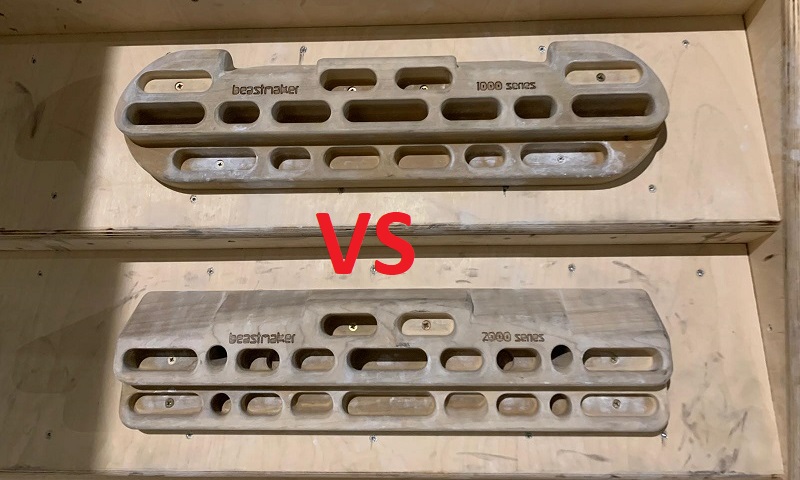
I get asked this question a lot.
At my local climbing gym, I’ve been able to intensively train with both these fingerboards, and here’s what I can tell you from my personal experience:
The Beastmaker 1000 is way better suited for beginners than the Beastmaker 2000.
That is why most people decide to buy the Beastmaker 1000, and not the 2000.
You can look at it this way:
You want to buy the Beastmaker 1000 if you still need to be made a beast. Go get the Beastmaker 2000 when you’re already a beast.
The reason for this, is that both the pockets and the slopers on the Beastmaker 2000 are a lot more difficult to hold on to.
For example, compare the jugs on the extremities of the Beastmaker 1000 to the slopers on the 2000. You can easily see that the 1000 gives you plenty of room to hold on to. The 45 degree angle of the sloper on the 2000, however, is really hard to hold on to. I can tell you from personal experience that those slopers are really not made for beginners – I’m still struggling with them and often prefer to use to Beastmaker 1000 over the 2000.
A second point of attention when it comes to comparing the Beastmaker 1000 to the Beastmaker 2000, is the depth of the finger pockets. These are deeper on the 1000 than on the 2000.
‘The finger pockets are deeper on the Beastmaker 1000 than on the Beastmaker 2000.’
This means that beginners will struggle less with training on the Beastmaker 1000. And to be fair, even if you’re getting better at hanging from a fingerboard, the beastmaker 1000 still does the job almost as good als the beastmaker 2000. After all, you don’t have to use the entire finger pocket, just because there’s enough space for your fingertips. You can just as easily hang from half a fingertip on the beastmaker 1000 as on the beastmaker 2000. On the 2000, however, you’re forced to use less skin surface.
So in conclusion: The two main differences between the Beastmaker 1000 and the 2000, is the depth of the finger pockets and the type of sloper / jug on them. These differences make it so that the 1000 is a lot better for beginners than the Beastmaker 2000. I therefore recommend the Beastmaker 1000 to most people, simply because the beastmaker 2000 is just there for the die hard climbers and wasn’t made to accomodate the fingerboard needs of beginners. Most people breaking into serious training on a fingerboard, will have a great fingerboard for years when they choose to buy the beastmaker 1000. If you’re in your fifth year of climbing or so, you may finally want to consider adding the Beastmaker 2000 to your training equipment.
The Bottom Line
Investing in the right fingerboard is important to your development as a serious rock climber.
Consider the tips above to help make sure that you choose the fingerboard right for you.




